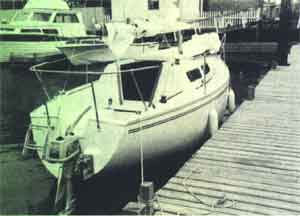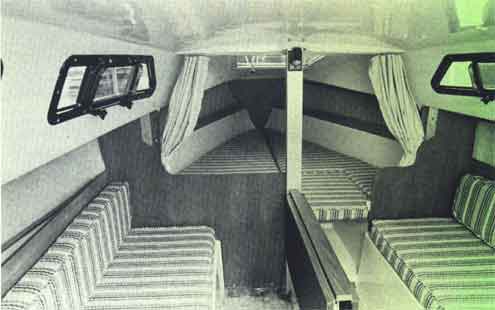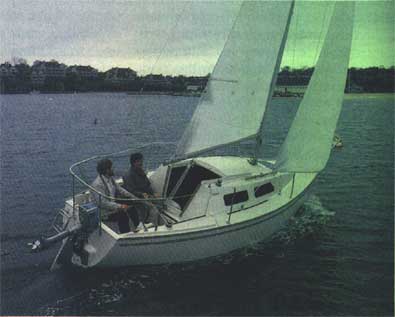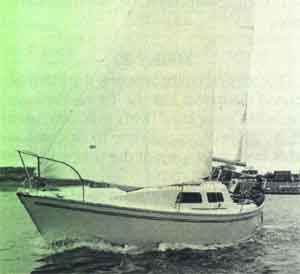| SJ23 Tech Tip, (Bob Schimmel ) |
|
SJ23 Review written by Mike O'Brien, photos by J.H. Peterson. |
| This is a 1986 review of a San Juan 23. Better yet a
comparison to similar boats of similar vintage. I show only
the SJ23 results here. To read the reviews on
the other boats, go to http://www.widgetsailor.com/sbjournal/seatrials86/st1.html
|
REVIEW: The San Juan 23 is a cruising design derived from Bruce Kirbyís successful racer, the San Juan 24. While the San Juanís modified ďblisterĒ house that looks so sleek on larger racers loses some of its style when placed on a short, high-sided hull, it does provide plenty of room below. A simple, open layout is enlarged visually with the use of partial bulkheads as shown above. For a 23 footer, the teak-trimmed galley is large and easily worked, but its athwart ship location beneath the companionway means you must be careful lest the crew step on your supper. A folding table mounted on the centerboard trunk adds a nice, functional touch. The berths (aft) extend well into the main cabin. No coffin quarter berths here. The settee backs are too far outboard (or the house sides too far inboard) for a sailor of normal height to sit against without slouching or hitting their head. This is a common problem aboard most of the boats we sailed. Only the Tanzer and Merit avoid it with their raised-deck construction. As in the Sirius, this San Juan cabin sole is carpeted.
The trip forward is comparable to that on the other
boats we sailed; the shrouds get in the way, but the foredeck is
easily worked. Like the Starwind and Sirius, an anchor locker is molded
into the foredeck. (Later MKI & MK II versions only). The lifeline stanchions are probably strong enough,
but the posts fit loosely into the bases and lack the secure feel of an
all-welded system. Steinmetz considered the two 5" mooring cleats at the bow much too small. The two 6" cleats at the bow he felt would be
barely adequate. The legitimate chocks did make him happy. Good,
chafe-reducing chocks are becoming distressingly rare items on small
production boats. Like the Starwind, the San Juan features a swim ladder
on its transom.
The San Juan is responsive to its helm and sail controls, and beginning sailors will learn their lessons quickly. With its racing heritage, the 23 begs for just a few go-fasts, perhaps a spinnaker or genoa or two. Good deck space and slotted toe rails should make adding the necessary hardware fairly easy. San Juan combines chop and roving in amounts sufficient to produce a stiff hull. Balsa core adds additional stiffness to the deck lay-up without a weight penalty. Exterior molded surfaces are smooth, fair, and uniform in finish and color. Some interior panels showed minor fabric print-through, but not enough to be objectionable. The 23 carries its 900 pounds of lead ballast in a fiberglass stub-keel. The 65-pound galvanized steel centerboard is easily handled by block-and- tackle in the cabin. NOTE: The above comments are reflective of the later version MKI SJ23. The windows shown above are not standard. The standard windows are permanently closed. Bob Schimmel.
|
|
HOW MUCH DID a 1982 San Juan 23 COST? While dealer mark-ups varied slightly depending on seasonal incentives, the 1983 boats retailed at $12,795.00 FOB plus (in my case) $3964.22 in freight charges from Auburn, WA to the Buffalo NY Area*. The sail inventory was not included in the price, which was another $425.00 for a racing main ($390.00 for a cruising main), $280/$258 for the jib, $360.00 for the 153% Genoa and $460.00 for the spinnaker. Of course VHF radio, instrumentation, compass, outboard and mount, boarding ladder and safety equipment were extra as well. (*Source: Clark Sails Price Sheet, "Effective April 15, 1982"). It would easily have been possible to have $20-21,000 tied up in the boat when it went into the water initially--another $1200-$1500 if you added a new trailer to the deal. |
|
I consider the SJ23 to be a capable protected water cruiser but would not
sail her to the
west side of Vancouver Island in any kind of weather. One should
pick a weather window and know where the hurricane holes are. It would be
sporting enough to sail her through the Gulf Islands or other large body
of water. It is prudent to run
for shelter when a small craft warning is announced on the VHF. The tight
interior may make your stay at anchor challenging during extended lousy weather,
so pick a place where you can go to shore to stretch your legs.
A bakery, farmers market or a pub works for me. If your boat qualifies for all the above then pick your weather, create a significant safety margin, submit a float plan, include a contingency plan and stay tuned to the weather channel. I'm sure your significant other will appreciate it if you prepay your life insurance and update your will prior to the trip! A phone call on your arrival would be nice. Bob Schimmel. |
|
Return to Techtip Index. . . . . . . . . . . . . . . Got a Trouble or a Question? |
 INTRODUCTION: Our visit to
the 1986 Small Boat Show in Newport, Rhode Island, was a real
businessmanís holiday. Several small cruising boats were invited for sea
trials and we spent the whole weekend
sailing the following five boats:
INTRODUCTION: Our visit to
the 1986 Small Boat Show in Newport, Rhode Island, was a real
businessmanís holiday. Several small cruising boats were invited for sea
trials and we spent the whole weekend
sailing the following five boats:  It became quite clear that each boat has a distinct personality, reflected in the type of compromises each designer and builder made within the confines of a 22 to 23 foot hull. Thomas Baker and I, technical editor for Soundings, examined and sailed these boats while keeping in mind what you might want to know.
Between us we had a total of 54 years
of sailing experience. Our expert builder, Ken Steinmetz of Kenís Boat Shop in Seaford, New York, scrutinized every detail of
hull construction. The weekend brought good sailing weather with 8-15 knot breeze, a moderate chop, and just enough fog to keep things interesting.
It became quite clear that each boat has a distinct personality, reflected in the type of compromises each designer and builder made within the confines of a 22 to 23 foot hull. Thomas Baker and I, technical editor for Soundings, examined and sailed these boats while keeping in mind what you might want to know.
Between us we had a total of 54 years
of sailing experience. Our expert builder, Ken Steinmetz of Kenís Boat Shop in Seaford, New York, scrutinized every detail of
hull construction. The weekend brought good sailing weather with 8-15 knot breeze, a moderate chop, and just enough fog to keep things interesting.  The SJ23 cockpit is on the small side for more than
three sailors (thatís where some of the cabin room comes from), but
with its carefully angled, 14" deep backrests, itís most
comfortable. The San Juan was the only boat in the trials equipped with
a traveller, a joy for those who take sail trim seriously. Located on the bridge deck
it is handy for the helmsman, but does cut into the
accessibility of the companionway.
The SJ23 cockpit is on the small side for more than
three sailors (thatís where some of the cabin room comes from), but
with its carefully angled, 14" deep backrests, itís most
comfortable. The San Juan was the only boat in the trials equipped with
a traveller, a joy for those who take sail trim seriously. Located on the bridge deck
it is handy for the helmsman, but does cut into the
accessibility of the companionway. This should not be regarded as a luxury item. On a high
sided boat, it is very useful in the event someone needs to be
rescued.
This should not be regarded as a luxury item. On a high
sided boat, it is very useful in the event someone needs to be
rescued.  OFFSHORE CAPABILITY - Several
club members have set their eyes on the Bahamas and asked my opinion on
the offshore capabilities of an SJ23. I realize this passage is very
tempting because it is only a two day jaunt across open water to some
very tropical climate.
Several SJ23s have made the crossing, which is pretty good performance when you compare it to some long lake passages that many sailors have made.
While I do all my modifications to Panache to literally prepare
her for "WWIII" or a long passage like this, in my view point she is still not an offshore
boat. Here are some of my thoughts;
OFFSHORE CAPABILITY - Several
club members have set their eyes on the Bahamas and asked my opinion on
the offshore capabilities of an SJ23. I realize this passage is very
tempting because it is only a two day jaunt across open water to some
very tropical climate.
Several SJ23s have made the crossing, which is pretty good performance when you compare it to some long lake passages that many sailors have made.
While I do all my modifications to Panache to literally prepare
her for "WWIII" or a long passage like this, in my view point she is still not an offshore
boat. Here are some of my thoughts;